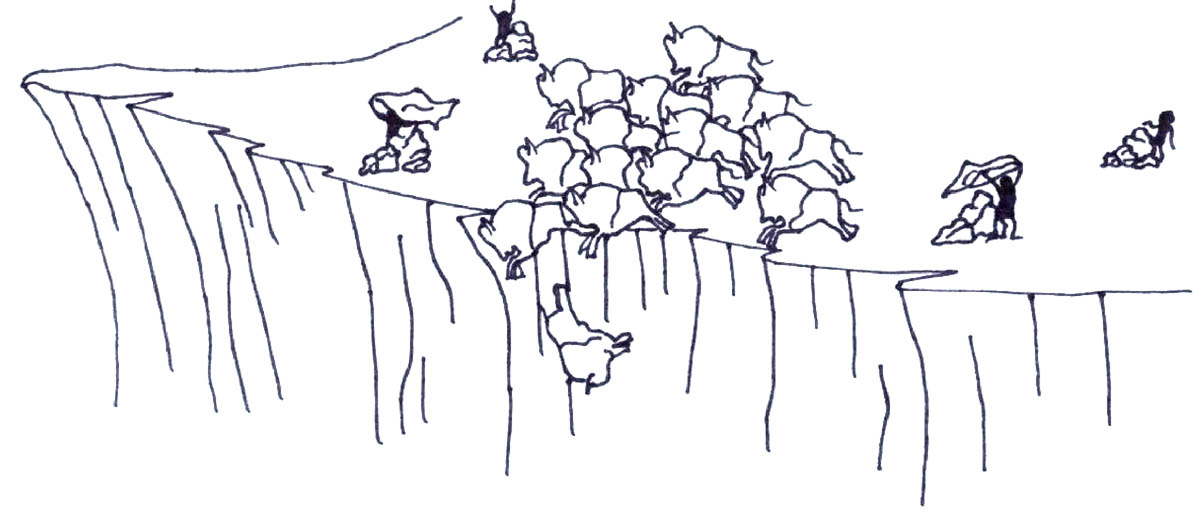
Archeological evidence at several buffalo jumps suggests that most jumps were conducted in the fall. Bones of mature cows and yearling calves are the most often uncovered at these dig sites. The fall, after the "rut" or mating season, is the time this herd structure is common.
Although hundreds of bison may have been killed in a single jump event, the people would use as much of the carcasses as possible. Hides would be used for clothing, shelter, and bedding. The hair and tail could be used to make rope and fly brushes. Sinew from the muscles made thread, glue, and bow strings. Bones and horns were used to make a variety of tools for everyday use. All of the meat was consumed some during the celebration and ceremonies of a successful kill, must most was dried for use during the winter. Almost every part of the animal was used.
As in all situations, change is inevitable and change for the Plains Indians method of hunting came with the horse. Horses were obtained by the Plains Indians early in the 1700s. Their use for hunting and as beasts of burden spread quickly among tribes throughout the continent, including the plains people.
Once horses were abundant, native people switched to a nomadic way of life rapidly. The use of horses allowed following the bison herds, hunting for fresh meat year round, as opposed to large communal hunts in the fall.
The bison jump quickly became an obsolete method for hunting bison. A skilled rider could target a single animal; the meat, hide, and all useful parts could be transported longer distances. Within a few decades, the plains people had become horse people.
By the time of westward expansion, the horse people of the plains were in their full glory and buffalo jumps were only stories of the courage and cooperation of their ancestors.
Materials:
Read The Buffalo Jump
written by Peter Roop
and illustrated by Bill Farnsworth
One ten-foot piece of string/yarn per student. Mark off 1-foot intervals with a piece of tape or a marker. This can be done either ahead of time or have students do it.
One-stop watch or timer (to the second) per group off three. You could also teach students how to count…1-1000, 2-1000, etc.)
Pack of sticky notes these would work best to make a graph later
Roll of tape or something to mark where the runner starts and stops
One pencil per group.
A large area for running and measuring 50-100 yards.
Learning Activities:
1. Read aloud The Buffalo Jump written by Peter Roop and illustrated by Bill Farnsworth.
2. Discuss what units of measurement you would use to measure how far someone can run both long and
short distances. If you haven’t already measured out the string with one-foot intervals marked, you could
have the students do that now. This takes a little longer, but will give them practice measuring in one foot
increments with a ruler and ownership in making their measuring string.
3. Demonstrate how to cooperatively measure distances by laying the 10-foot strings end to end and
repeating the process over until you reach your measurement. Also demonstrate how to time the runners.
If you don’t have a stopwatch you can teach kids how to time by saying: 1--1000, 2—1000, …up
to…10--1000.
4. Divide the class into groups of three. They will each take turns being the “runner”, “timer”, and
“referee”.
Mark off a starting line and have the “runner” line up behind the line.
The timer will give a signal to the runner to start and start the time.
The referee will follow the runner.
When 10 seconds are up the timer says or signals the runner to stop.
The referee marks off the spot the runner reached in 10 seconds.
The group then works together with their yarn to measure the distance of the runner.
The runner then writes down their name and the distance they ran in 10 seconds on a sticky note.
Repeat the process until everyone has ran and measured.
5. Collect the sticky notes and use them to make a bar graph on the board. You could extend this activity by showing the class average and/or mode.
6. Discuss who would be a good buffalo runner and why?

No comments:
Post a Comment